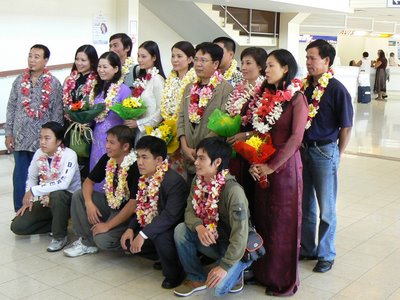A fugitive moment of grace: life story, migration and Vietnamese-Caledonian women.
Sur ce site je viens de trouver la présentation d’un article en anglais (tant pis) , basé sur des interviews de femmes vietnamiennes vivant en Nouvelle-Calédonie.
Je ne sais pas si l’article vaut son pesant de cacahuettes mais l’auteur n’est pas une débutante.
Dire que j’en ai jamais entendu parler :o(
Publication: Hecate
Publication Date: 01-MAY-05
Delivery: Immediate Online Access
Author: Johnson, Helen
Article Excerpt
Introduction
When I first arrived in New Caledonia I learnt that a small and lively Vietnamese community existed and that rice was a staple food in most households. I have since discovered that few people beyond New Caledonia's shores know of the Vietnamese-Caledonian community despite the archipelago's geographic proximity to Australia's eastern coast and the many South Vietnamese who migrated to Australia following the war with North Vietnam in the 1960s and 1970s.
Although several anthropologists have noted that some informants will not use life story to represent their subjectivity and sense of social identity, I learnt from almost a decade of field research that Vietnamese-Caledonian people's frequent recourse to life story was notable. In defining life story as an 'oral account of a life or segment of a life as told by an individual' I did not come to my research with the assumption that lived experience is 'best understood through a reconstruction of the natural narrative order in which it is lived'. Rather my Vietnamese-Caledonian interviewees substantiated Clandinen and Connelly's observation that when persons note something of their experience, either to themselves or to others, they do so not by the mere recording of experience over time, but in storied form. Story is, therefore, neither raw sensation nor cultural form; it is both and neither. In effect, stories are the closest we can come to experience as we and others tell of our experience. A story has a sense of being full, a sense of coming out of a personal and social history.
Life story was my interviewees' preferred mode to represent their sense of 'who they are', 'how they came to be Vietnamese-Caledonian', and how they located their lived experiences within a local and global community they termed 'chez les Viets'. Through the interview process they lived their stories and, in the telling of them, reaffirmed, modified, and created them anew.
Over time I gathered a range of life stories that uncovered the social, political and economic imperatives which formed part of the collective and relational meaning systems that had impelled Vietnamese people to migrate to New Caledonia, to migrate from it, or to remain part of the Vietnamese-Caledonian community. Many anthropologists have regarded people as settled in local communities or as migrants who are relocating to new places, while others are now directing their attention to 'the cultural and social significance of moving in space and the transnational communities which may result'. Vietnamese-Caledonian people's life stories contribute to both research arenas. Most interviewees recognised the existence of a localised community in New Caledonia yet frequently constructed their subjectivity in terms of 'being Viet' as forming part of a transnational sociopolitical community referred to as 'chez les Viets'. Indeed, this phrase occurred so frequently in life story that I noted it was a motif of social identity that participants strategically employed as members of a community to derive meaning from, and add sense to their experiences.
In listening to their life stories I also learnt that 'how they came to be Vietnamese-Caledonian' had been profoundly shaped by migration. I recognise that examinations of the dilemmas and strategies of migration in the Asia-Pacific are common, and I do not claim to present here a definitive nor a representational study of the local Vietnamese-Caledonian community's migration challenges. Rather, I wish to promote understanding about how life story was used by Vietnamese-Caledonian women to represent their lived experiences, and to contextualise these within the broader political, economic, and sociocultural framework of their migration... .
Materials for this article were gathered from three years of participant observation in New Caledonia from 1995 to 2003 and in-depth interviews with fifty Vietnamese-Caledonian participants, all of whom live in Noumea, the capital and primary township. Following conventional ethnographic practice I used 'conversations with a purpose' in order to engage in as informal a face-to-face encounter as possible. During my first field trip to New Caledonia I was befriended by Renee, a Vietnamese-Caledonian woman who arranged many interviews for me on later trips via her extensive network of family and friends. During social events I was also able to engage in informal conversations, to use 'snow-balling' to access further potential participants, and to conduct unstructured and in-depth interviews. Nonetheless, my informants' preference for life story confirmed that, as an ethnographer, I was engaged in 'active constructionist activity' in that it was my presence and the questions I asked that prompted the telling of life stories. Informal conversations lasted from thirty minutes to up to five to six hours if they were conducted during leisurely meals but, like the interviews, usually were between sixty to ninety minutes in duration. All informal conversations and most interviews were conducted in French but three interviews with elder Vietnamese-Caledonian women were conducted in Vietnamese, were translated into French en situ by a member of their community, then transcribed into English.



















